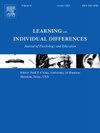Reading in print and digitally: Profiling and intervening in undergraduates' multimodal text processing, comprehension, and calibration
IF 3.8
1区 心理学
Q1 PSYCHOLOGY, EDUCATIONAL
引用次数: 0
Abstract
This study reports on two experiments exploring differences in comprehension when students read multimodal documents (i.e., text and visual) in print and digital mediums. In Study I, 70 undergraduates read excerpts from an introductory geology textbook in print and on a computer screen. Data from comprehension and judgment of performance measures indicated that students comprehended better and spent more time reading in print than they did on screen. Based on processing behaviors, reading times, and judgments of performance accuracy (i.e., calibration), three clusters were identified. In Study II, 65 participants from Study I took part in an intervention aimed at improving students' comprehension and calibration when reading digitally. Students then read a multimodal text on the topic of volcanoes on screen. Analyses demonstrated that participants' comprehension scores and duration of reading were significantly improved over their performance in Study 1. However, calibration accuracy scores worsened for these participants following the intervention.
Educational relevance statement
Two studies examined how well students comprehended when reading in print and digitally, and how well they judged their performance in each medium. Based on reading time, reading behaviors, and comprehension scores, students read longer and understood more when they read in print. However, their performance judgments were poor under both mediums. After participating in an intervention aimed at improving comprehension and accuracy judgments for the digital medium, students' comprehension and the time they spent reading improved, but not their performance judgments.
本研究报告了两项实验,分别探讨了学生在阅读印刷和数字媒体的多模态文件(即文本和视觉)时的理解差异。在研究 I 中,70 名本科生阅读了一本地质学入门教科书的印刷版和电脑屏幕版节选。从理解和成绩判断测量数据来看,学生对印刷品的理解比对屏幕的理解更好,花费的阅读时间也更长。根据处理行为、阅读时间和对表现准确性的判断(即校准),确定了三个群组。在研究 II 中,研究 I 中的 65 名参与者参加了旨在提高学生数字阅读理解能力和校准能力的干预活动。学生们在屏幕上阅读以火山为主题的多模态文本。分析表明,与研究一中的表现相比,参与者的理解力得分和阅读持续时间都有显著提高。教育相关性声明两项研究考察了学生在阅读印刷和数字文本时的理解能力,以及他们对自己在每种媒介中的表现的判断能力。从阅读时间、阅读行为和理解能力得分来看,学生在阅读印刷品时,阅读时间更长,理解能力更强。然而,他们在两种媒介下的表现判断都很差。在参加了旨在提高对数字媒体的理解力和准确性判断力的干预活动后,学生的理解力和阅读时间都有所提高,但对表现的判断力却没有提高。
本文章由计算机程序翻译,如有差异,请以英文原文为准。
求助全文
约1分钟内获得全文
求助全文
来源期刊

Learning and Individual Differences
PSYCHOLOGY, EDUCATIONAL-
CiteScore
6.60
自引率
2.80%
发文量
86
期刊介绍:
Learning and Individual Differences is a research journal devoted to publishing articles of individual differences as they relate to learning within an educational context. The Journal focuses on original empirical studies of high theoretical and methodological rigor that that make a substantial scientific contribution. Learning and Individual Differences publishes original research. Manuscripts should be no longer than 7500 words of primary text (not including tables, figures, references).
 求助内容:
求助内容: 应助结果提醒方式:
应助结果提醒方式:


